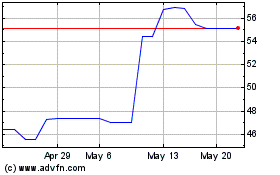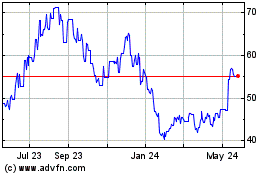Lego CEO Sees Potential for Brand in Digital Products
08 December 2016 - 10:00PM
Dow Jones News
Lego A/S's top boss says he is eager to hear more business
proposals when taking on a new assignment in January. He warns,
however: his job will also be to say no.
After a 12-year tenure as chief executive of the Danish toy
brick-maker, Jø rgen Vig Knudstorp has been appointed chairman of a
new umbrella-entity, the Lego Brand Group, where he will be the
chief custodian of the four-letter brand, from merchandising to
charity.
His new role, he says, will be to expand Lego into uncharted
business territory, while also avoiding putting the brand name in
the wrong places.
"I'm going to do brand protection and development, in parallel,"
he said in an interview. "Our history is fraught with mistakes, and
we don't plan to repeat them."
Mr. Knudstorp has firsthand experience of how botched
diversification can hurt a company and its brand.
When he took office as Lego CEO in 2004, the family-owned
company was in pieces, with dwindling sales and swelling losses. In
a bid to generate new revenue streams, Lego had ventured into
running theme parks, launching clothing lines, dolls, baby toys and
numerous other products with little commercial success.
Many companies are grappling with how to harness a brand without
harming it.
At the turn of the decade, Finnish mobile-game maker Rovio
Entertainment Ltd. entered others activities like films, theme
parks and various merchandises, hoping that its 'Angry Birds' game
would help it become a Walt Disney Co.-style business. It worked
for a while: In 2013, nongame activities brought in half of Rovio's
revenue. But as interest in 'Angry Birds' games diminished, the
brand lost some of its appeal, forcing Rovio to slash jobs.
German sporting goods firm Puma SE only recently recovered from
years of terrible sales and uncontrolled diversification that
tarnished its image. In the early 2000s, aiming to harvest the
fruits of a well-recognized brand, Puma began putting its name on
anything from bikes to perfumes and sunglasses. Not until it
returned to its core, sportswear, have numbers again turned
black.
During Mr. Knudstorp's time as CEO, Lego got rid of all noncore
assets and took a cautious approach to investments. Films,
videogames and theme parks are now largely handled by third-party
companies.
"There may be a limit to how much Lego can really do outside of
construction toys," said Matthew Hudak, an analyst at the
Euromonitor consultancy, adding, "It may be that consumers interest
in the Lego brand does not extend too far outside of the
construction toy category."
Mr. Knudstorp has some ideas. The biggest untapped growth
potential for Lego lies in the digital world, he says, adding
that potential partners keep knocking on his door.
Lego has been approached to develop games similar to Sweden's
Minecraft, now owned by Microsoft Corp., that would allow children
to manipulate bricks to learn computer coding. Other proposals
include different ways of combining phone scanning technology with
children's bricks play.
"There is an endless range of opportunities," Mr. Knudstorp
said.
While focusing on the brand, Mr. Knudstorp said he intends to
retain some down-to-earth duties. These include meeting partners in
countries like China to guide them in local business decisions and
spending more time with retail and media associates like Toys-R-Us,
Inc. and Walt Disney Co.
Lego Chief Operating Officer Bali Padda, who will take over as
CEO from Jan. 1, said he wasn't worried about him and Mr. Knudstorp
stepping on each other's toes.
"It's the brick-based business that I'm really wanting to
drive," he said. "The other things, he can do."
Write to Ellen Emmerentze Jervell at ellen.jervell@wsj.com
(END) Dow Jones Newswires
December 08, 2016 05:45 ET (10:45 GMT)
Copyright (c) 2016 Dow Jones & Company, Inc.
Puma Ag Rudolf Dassl (PK) (USOTC:PMMAF)
Historical Stock Chart
From Dec 2024 to Jan 2025

Puma Ag Rudolf Dassl (PK) (USOTC:PMMAF)
Historical Stock Chart
From Jan 2024 to Jan 2025
